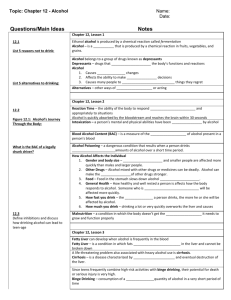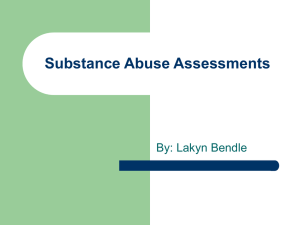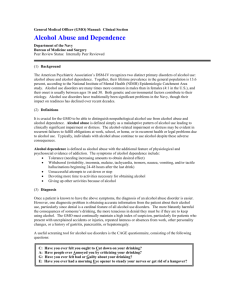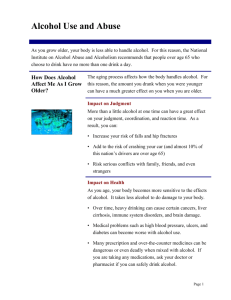Document 9015540
advertisement
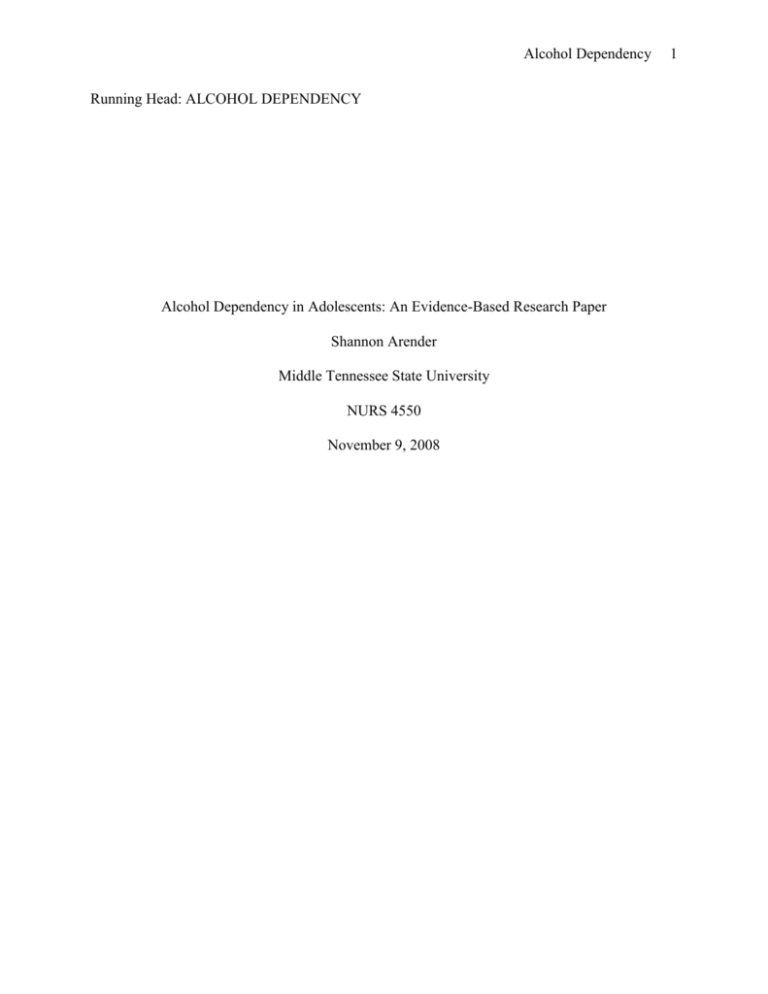
Alcohol Dependency Running Head: ALCOHOL DEPENDENCY Alcohol Dependency in Adolescents: An Evidence-Based Research Paper Shannon Arender Middle Tennessee State University NURS 4550 November 9, 2008 1 Alcohol Dependency 2 Abstract This evidence-based research paper is on the mental health disorder of alcohol dependence among adolescents. The research paper includes epidemiology/incidence, etiology/pathogenesis, medical complications, assessment and diagnosis, treatment, holistic considerations, and implications for nursing research in regards to alcoholism in America’s young adults. Alcohol Dependency 3 Alcohol Dependency in Adolescents Alcoholism among teenagers is currently on the rise in America today, with an astounding 11 million underage drinkers (U.S. Department of Health & Human Services, 2007). These children do not realize the inevitable consequences they may face in the future when they take that first drink they believe is a rite of passage into adulthood. Alcoholism is defined as extreme dependence on excessive amounts of alcohol, associated with a cumulative pattern of defiant behaviors. Alcohol is a chronic illness with slow, insidious onset, which may occur at any age (National Institute on Drug Abuse, 2007). It is so important for America to fight to eliminate this escalating problem because of its terrible effects on our youth as a country because the earlier the age of onset, the greater the risk of dependence (Frances, Miller, & Mack, 2005). In 2007, the surgeon general issued a national call to action on underage drinking. Research shows that these teens that start drinking before the age of 15 are five times more likely to have alcoholrelated problems later in life. Also, new research indicates that alcohol may harm the developing adolescent brain (National Institute on Drug Abuse, 2007). This evidence-based research paper includes the epidemiology/incidence, etiology/pathogenesis, medical complications, assessment and diagnosis, treatment, holistic considerations, and implications for nursing for the mental health disorder of alcohol dependency among teens. Epidemiology Of the nearly 11 million underage drinkers in the United States nearly 7.2 million are considered binge drinkers, and more than two million are classified as heavy drinkers. Binge drinkers are the young adults that drink more than five drinks on occasion, e.g., at parties or sporting events, but not on a regular basis (U.S. Department of Health & Human Services, 2007). Heavy drinkers drink more than 5-7 drinks a day and/or 35-50 drinks a week (Jorgensen, 2008). Alcohol Dependency 4 In general, male teenagers use more alcohol, as well as other substances, than do females. But the differences between male and female substance abuse are consistently growing smaller, which is probably due to the fact that girls are maturing at earlier ages than ever before (Frances et al., 2005). In relation to college students, ages 18-24, approximately 80 percent of them engage in episodic drinking. Thirty-one percent of these students met criteria for a diagnosis of alcohol abuse, and six percent for a diagnosis of alcohol dependence according to self-reports (College Drinking Prevention, 2007). Alcohol abuse not only has negative affects on the abuser, but the society as well. The following table is a snapshot of the consequences of alcohol use. Table I ______________________________________________________________________________ Consequences of Alcohol Use in Teenagers___________________________________________ Each year over 10,000 young people are killed, and 40,000 are injured in alcohol-related automobile accidents. 599,000 young adults, between ages 18 and 24 are unintentionally injured under the influence of alcohol. More than 696,000 young adults are assaulted by another student who has been drinking. More than 97,000 young adults are victims of alcohol-related sexual assault or date rape. 400,000 young adults took part in unprotected sex, and more than 100,000 reports having been too intoxicated to know of they consented to having sex. More than 150,000 young adults develop alcohol-related health problems and between 1.2 and 1.5 percent indicated that they tried to commit suicide within the past year due to ______drinking or drug use._______________________________________________________ (College Drinking Prevention, 2008) Etiology/Pathogenesis Alcohol addiction is considered a brain disease because alcohol changes the brain’s structure and how it works, which typically results in long-term damage. Addiction is a preventable disease, in which teenagers begin taking the drug for a variety of reasons that may Alcohol Dependency 5 include: to feel good, feel better, escape suffering, to improve athletic or cognitive performance, curiosity, or because of peer pressure. Also, some adolescents are just more vulnerable to addiction, which is why some teens become addicted while others do not (National Institute on Drug Abuse, 2007). Risk factors for alcohol dependence include adolescents with a family history of substance abuse, drug-abusing friends/peers, genetic factors, teens who have preexisting mental disorders, such as, depression, teens who have low self-esteem, and teens that feel they do not fit in or are out of the mainstream (American Academy of Child and Adolescent Psychiatry, 2008). According to a study done by Zwaluw, Scholte, Vermulst, Buitelaar, Verkes, and Engal, children of alcoholics are not only at a higher risk for early alcohol initiation, but they also show a greater incidence in alcohol consumption over time than adolescents without alcoholic parents (2008). Ketcham and Pace also support the genetic theory that genes play a profound role in the likelihood that a teen will become chemically dependent. They propose that alcoholics are likely to have inherited a deficiency of receptors for dopamine, a chemical that makes people feel good (2003). If one parent is alcoholic, the risk of addiction for the child is approximately forty percent or about four times the general population. If both parents are alcoholics the risk increases to about sixty percent (Ketcham & Pace, 2003). In a study done by Deas, Germaine, and Upadhyaya gender differences play a role in how dependency affects adolescents (2006). They found that tobacco and alcohol tolerance rates are more pronounced in male adolescents than female adolescents. There are also psychological and sociocultural theories to the etiology of alcohol dependence. Psychodynamic theories view substance use as a defense against anxious impulses, a form of oral regression, or self-medication for depression. Behavioral theory focuses on the positive reinforcing effects of drug-seeking behaviors (Varcarolis, Carson, & Shoemaker, 2006). Sociocultural theories include ideas that one’s cultural Alcohol Dependency 6 norms influence when, what, and how a person uses substances (Varcarolis et al., 2006). There is no definite, single cause of alcoholism, though. There are multiple factors that may contribute to putting person at risk for developing alcoholism, e.g., a child with alcoholic parents, as well as, low self-esteem. Assessment Assessment is becoming increasingly difficult because more and more adolescents are using a number of drugs simultaneously, or have a coexistent psychiatric problem. To detect an alcohol problem, caregivers may ask two questions: (1) In the last year, have you ever drunk more than you meant to? (2) Have you felt you wanted or needed to cut down on your drinking in the last year? During the interview process, when assessing a young patient, questions should be asked in a direct, matter-of-fact manner (Varcarolis et al., 2006). The specific details about alcohol use that should be addressed are: how much do you drink, how often, what time of day, where, how/where do you attain alcohol, do you feel pressure to drink when you are around your friends? Since teens may be ashamed or scared that they may get in trouble, they may consistently deny or say what they believe to be the right answer. Parents should look for physical, emotional, family, school, and social problem related warning signs. Physical warning signs include fatigue, repeated health complaints, and red, glazed eyes. Emotional signs may include personality change, sudden mood changes, irritability, irresponsible behavior, low selfesteem, poor judgment, depression, and a general lack of interest. Starting arguments, breaking rules, or withdrawing from the family and all warning signs to look out for in a teenager’s relation to family. A dependent teen may also have a decreased interest in school, negative attitude, a drop in grades, increased absences, and discipline problems. Social problem warning signs include the following: new friends, problems with the law, and a change in dress and music Alcohol Dependency 7 to less conventional styles (American Academy of Child and Adolescent Psychiatry, 2008). Diagnosis Alcohol dependence diagnosis is based on the DSM-IV-TR criteria for substance abuse and dependence. The DSM-IV differentiates between substance abuse and substance dependence. To be considered for the substance abuse diagnosis the patient must show a maladaptive pattern of substance use leading to clinically significant impairment or distress, manifested by one or more of four symptoms within a 12 month period. The four symptoms include: (1) inability to fulfill major role obligations at work, school, and home, (2) participation in physically hazardous situations while impaired, (3) recurrent legal or interpersonal problems, (4) continued use despite recurrent social and interpersonal problems (Varcarolis et al., 2006). To qualify for a DSM-IV diagnosis of substance dependence, the patient must present with at least three of the seven symptoms within a 12 month period. The seven symptoms of dependence include: (1) tolerance, (2) presence of withdraw syndrome, (3) substance is taken in larger amounts/for longer period than intended, (4) unsuccessful of persistent desire to cut down or control use, (5) increased time spent, getting, taking, and recovering from the substance; may withdraw from family or friends, (6) reduction or absence of important social, occupational, or recreational activities, (7) substance used despite knowledge of recurrent physical or psychological problems or that problems were caused or exacerbated by one substance (Varcarolis et al., 2006). According to this system of classification a substance abuse diagnosis typically precedes a substance dependence diagnosis. When the DSM-IV system is applied to adolescents there are cases when these patients do not receive a diagnosis because they may meet one or two of the dependence symptoms and no abuse symptoms (Deas, Roberts, Grindlinger, 2005). This method may impedes teenagers from receiving a necessary, proper treatment. In a Alcohol Dependency 8 study performed by Deas, Roberts, and Grindlinger, it was concluded that there is a degree of heterogeneity among the DSM-IV system for diagnosing substance abuse and dependence in adolescents (2005). Medical Complications Alcohol is known to cause a number of negative complications in adolescents. DSM-IV, along with defining diagnoses, includes eleven alcohol-induced disorders, which consists of alcohol intoxication, alcohol withdraw, delirium, alcohol-induced persisting dementia, anxiety, affective, or psychotic disorder, sleep disorder and sexual dysfunction (Jorgenson & Maisto, 2008). Alcohol withdraw is the way in which a heavy, longtime drinker’s brain responds to the need for alcohol. Common symptoms of withdraw are tremor, sweating, anxiety or agitation, elevated blood pressure, increased pulse, increased respiration, headaches, nausea, vomiting, and light and sound sensitivity. In addition, alcoholism has devastating medical complications of the gastrointestinal (GI) tract and pancreas, liver, nutrition, cardiovascular system, nervous system, hematology, endocrine system, muscular-skeletal system, immune system, skin, cancer, and fetal effects (Frances et al., 2005). In relation to the GI tract, alcohol causes decreased peristalsis, decreased gastric emptying, and increased gastric secretions. Alcohol consumption is also known to be one of the most common causes of acute pancreatitis. Alcohol is especially toxic to the liver, causing liver damage and cirrhosis in many long-term drinkers. Since alcohol causes nutritional deficiencies, some signs of malnutrition include: thinning of the hair, ecchymosis, glossitis, abdominal distention, peripheral distention, and peripheral edema (Frances et al., 2005). In an investigation of university youth conducted by Jorgensen and Maisto, it was concluded that prehypertension and heavy alcohol consumption increase the risk for primary hypertension, a Alcohol Dependency 9 major cardiovascular-related morbidity and mortality (2008). Recent research studies have also concluded that alcohol may even have damaging effects on the adolescent brain. Alcohol damages the areas of the brain that are responsible for higher brain functions of problem solving and decision making, memory, learning, and movement coordination (National Institute on Drug Abuse, 2007). Holistic Considerations Side effects of alcoholism are not always limited to physical problems. Other consequences include academic impairment or failure, violence, rape and assault, unintended sexual activity, unintended pregnancy, sexually transmitted diseases, including HIV/AIDS, and vocational and criminal consequences that could jeopardize future job prospects (Boyd & Fayden, 2002). Teenagers are dramatically influenced by their family environment and relationships. A research study by Peele, even found that drinking varies tremendously among religious, ethnic, and national groups (2006). He found that groups that are less proscriptive towards alcohol and in fact permit and even teach drinking in childhood, and in which drinking is a regular integrated part of social life, display fewer alcohol problems (Peele, 2006). Yet in America, where alcohol use is strictly regulated and abstinence is emphasized, it has been proven that American adolescents who begin drinking earlier in life are more likely to display adult alcohol dependence (Warner & White, 2003). The presence of comorbid psychiatric disorders are often seen in adolescents with alcohol dependence. Behavior, mood, and/or anxiety disorders often increase the risk for development of an addiction in adolescents. Psychiatric disorders may precede alcohol dependence, may develop as a consequence of dependence, may influence the severity of dependence, or may not be related. The most common psychiatric disorders associated with alcohol addiction are conduct Alcohol Dependency 10 disorder, attention-deficit hyperactivity disorder (ADHD), aggressive behaviors, mood disorders, depression, anxiety, post-traumatic stress disorder, and teenagers with suicidal behavior (Frances et al., 2005). Treatment Treatment options for alcohol dependent adolescents include inpatient treatment programs, education and counseling programs, group therapy, and outpatient programs. Nearly all inpatient programs are based on the Minnesota Model of alcohol dependency treatment. The Minnesota Model focuses on the notion that alcoholism is a disease; also, treatment focuses on establishing and maintaining abstinence rather than trying to uncover and analyze the underlying psychological causes for drinking (Cermack, 2003). The Minnesota Model also adopted the twelve steps of Alcoholics Anonymous (AA) and introduces them through a series of classes and lectures. Other outpatient programs focus on the notion that alcoholism is a bad habit that must be approached very differently. The classes offer teaching methods for controlled drinking and do not go with the idea of total abstinence. Even though this program is very different than inpatient programs, it is still based on the twelve steps from AA. Total abstinence proves a better resolution for most teens though, because teens that are trying to quit drinking, but continue to smoke marijuana or even cigarettes, are still using chemicals to deal with emotions (Cermack, 2003). They are not overcoming addiction, they are replacing it. In the end, no treatment plan, whether inpatient or outpatient will work if the addicted adolescent is not fully committed or have the desire to quit. Education and process groups have also proved to be beneficial. Education on tools for coping with stress is extremely helpful to these addicted teenagers. Process groups work well because Alcohol Dependency 11 they allow the adolescents to see they are not alone, and that shared pain becomes lighter (Cermack, 2003). Support is also extremely important for growing and developing teens, especially from family members. Treatment for alcohol dependency in adolescents consists, not only treatment of the drug addiction, but also of the underlying behavioral and emotional problems they may have. A lot of time these teens are “self-medicating” their psychological problems, and as a result become addicted. They use alcohol to take the pain away from emotional and psychological problems. These issues should be addressed first. There are medicines that are developed to battle depression and other psychological disorders that should be used in the place of drugs and alcohol. Implications for Nursing Prevention and education are detrimental in stopping the increase in addicted adolescents. New approaches to educate teens deals with giving the kids honest, unbiased, factual information if they do choose to experiment, rather than the old abstinence only message. Organizations like Mother Against Drunk Driving (MADD) recognize that if the facts could not stop the teenagers from drinking, then at least teach them not to get behind the wheel (Moilanen, 2004). It is up to nurses to stay informed on current research and statistics. Nurses are the only people some adolescents will turn to with their problems, which makes is so important for nurses to stay informed and educated. Nurses must be aware that previous methods of education, e.g., Drug Abuse Resistance Education (DARE), are no longer considered effective in preventing alcohol use among teenagers. An advanced prevention strategy that should be used is based on a psychosocial approach. These programs are aimed at enhancing self esteem, social skills, and assertive skills for resisting substance use (Frances et al., 2005). Alcohol Dependency 12 A major challenge for health care providers is recognizing when a teen is a high risk of substance abuse and to intervene to reduce transitional risk (Frances el al., 2005). The surgeon general called to action in collaboration with the National Institute on Alcohol Abuse and the Substance Abuse and Mental Health Services Administration six goals: (1) foster changes that facilitate healthy adolescent development and underage drinking prevention, (2) engage parents, schools, communities, all levels of government, all social systems that interface with youth, and the youth themselves in a effort to prevent and reduce underage drinking and it consequences, (3) promote understanding of underage alcohol consumption, (4) conduct additional research on adolescent alcohol use and its relationship to development, (5) work to improve public health surveillance on underage drinking and on population based-risk factor for this behavior, and (6) work to ensure that policies at all levels are consistent with the national goal of preventing and reducing underage alcohol consumption (U.S. Department of Health & Human Services, 2007). Nurses should be aware of these goals set forth and strive to reach them when relating to teen clients. Conclusion Alcohol use in teens is a major problem in American today that desperately needs to be resolved. Too many of our future leaders, teachers, and parents are addicted to the fatal, liferuining drug of alcohol. Alcoholism is a preventable disease that should not be affecting young teens. It is so important for nurses, parents, and teachers to learn to detect symptoms and know how to recognize when a child is suffering from alcohol addiction. It is the job of nurses to educate these teenagers about the negative, medical and emotional consequences of addiction. Treatment plans are so incredibly important because it is far harder to recover from missed development as a teen than it is from missed opportunities as an adult. As one teen said about his Alcohol Dependency 13 past addiction, “I feel sad that I lost those years of my life and would give anything to get them back.” Alcohol Dependency 14 References American Academy of Child and Adolescent Psychiatry. (2008). Teens: Alcohol and Other Drugs. Retrieved November 1, 2008, from http://www.aacap.org/cs/root/facts_for_ families/teens_alcohol_and_other_drugs.html Boyd, G., Faden, V. (2002). The Contexts and Consequences of College Drinking. Journal of Studies on Alcohol, 14, 6-22. College Drinking Prevention. (2007). A Snapshot of Annual High-Risk College Drinking Consequences. Retrieved November 1, 2008, from http://www.collegedrinkingprevention .gov/StatsSummaries/snapshot.aspx Cermack, T.L. (2003). Marijuana: What’s a Parent to Believe? Center City, MN: Hazelden. Deas, D., Germaine, K., & Upadhyaya, H. (2006). Psychopathology in substance abusing adolescents: gender comparisons. Journal of Substance Use, 11(1), 45-51. Retrieved November 1, 2008, from CINAHL full text database. Deas, D., Roberts, J., & Grindlinger, D. (2005). The utility of DSM-IV criteria in diagnosing substance abuse/dependence in adolescents. Journal of Substance Use, 10(1), 10-21, Retrieved November 1, 2008, from CINAHL full text database. Frances, R., Sheldon, M., & Mack, A. (2005). Clinical Textbook of Addictive Disorders. New York: Guilford Press. Jorgensen, R.S. (2008). Alcohol Consumption and Prehypertention: An Investigation of University Youth. Journal of Behavioral Medicine, 34, 21-26. Retrieved November 1, 2008, from CINAHL full text database. Karson, J. (Ed.). (2007). Teen Addiction. New York: Thomas Gale. Ketcham, K. & Pace, N.A. (2003). Teens under the influence: The truth about kids, alcohol, and Alcohol Dependency 15 other drugs. NY: Ballantine Books. National Institute on Drug Abuse. (2008). Addiction and Health. Retrieved November 1, 2008, from http://www.drugabuse.gov/scienceof addiction/health.html National Institute on Drug Abuse. (2007). Drug Abuse and Addiction. Retrieved November 1, 2008, from http://www.drugabuse.gov/scienceofaddiction/addiction.html Peel, S. (2006). Reducing harms from youth drinking. Journal of Alcohol and Drug Education, 67-87. Retrieved November 1, 2008, from CINAHL full text database. U.S. Department of Health & Human Services. (2007). Acting Surgeon General Issues National Call to Action on Underage Drinking. Retrieved November 1, 2008, from http://www. hhs.gov/news/press/2007pres/20070306.html Varcarolis, E.M., Carson, V.B., & Shoemaker, N.C. (2006). Foundations of Psychiatric Mental Health Nursing: A clinical approach, (5th ed). St. Louis, MO: Elsevier. Warner, L.A., & White, H.R. (2003). Longitudinal effects of age at onset and first drinking Situations on problem drinking. Substance Use and Misuse, 38, 1983-2016. Zwaluw, C., Scholte, R., Vermulst, A., Buitelaar, J., Verkes, R.J., & Engal, R. (2008). Parental problem drinking, parenting, and adolescent alcohol use. Journal of Behavioral Medicine, 31, 189-200. Retrieved November 1, 2008, from CINAHL full text database.

